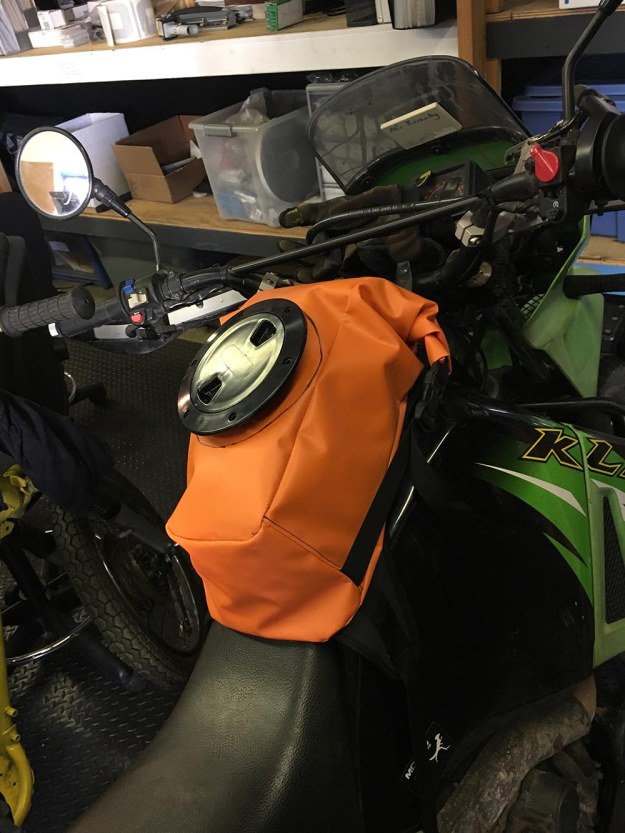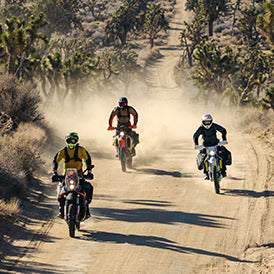Your Cart is Empty
Luggage
Apparel
Events
The Mosko Blog
Hatches, Bolt-Ons, & Tool Rolls
March 25, 2016
Hatches, Bolt-Ons, & Tool Rolls
March 25, 2016
Lots of product ideas in the air lately. This is a great time for development, because we’re all back from our various winter travels, our inventory is in production but hasn’t yet arrived, the show/rally season doesn’t start till May, and the weather’s still crap, meaning fewer outdoor distractions.
Tank Bags
The ‘hatch’ concept is getting close. Last week we mocked up two versions, one with a small hatch and roll-top, and the other with a big hatch and no roll-top.


We were torn between these. The small hatch/roll-top has a cool, thin profile, and has the advantage of a big roll-top to accommodate any size/shape item. However the smaller hatch access is tight, and to unroll the roll-top, you have to unsnap the bag from the bike. The large hatch version, on the other hand, offers plenty of access through a single opening, and provides more real estate for external pockets and features, at the expense of a wider bag. With the large hatch, we can also do more with the inside of the bag, in terms of internal organization, pockets, and storage.


We briefly considered doing both bags, but the hatch is such a new concept, we want to try it out with one version before committing to two. Plus we’d be ordering double the factory MOQ on a brand new concept and the bags would surely cannibalize each others’ sales. After much deliberation, we decided to start with just the large hatch version for now. It’s a nice, clean concept, and will probably be the better seller of the two. We can always add the smaller one later if the bigger one works.
Here’s what the bottom looks like, we’re going to add some compression molded foam to this surface as well.

This bag is nearly ready for prototyping.
Bolt-On
The bolt-on concept took a big step forward this week. This is where we were last week, with a simple roll top sack inside an outer carry harness:

We weren’t totally happy with the ‘grocery sack’ profile of the drybag so we started putting a bunch of other drybag samples and prototypes we have here laying around the shop into the harness to see how they’d fit. We found one that we really like, it’s a backpack prototype from our drybag factory. It fills the harness nicely and looks really tight on the bike.


Working with that foundation, we cut off the backpack straps and Andrew started experimenting with patterns and strap layouts. The big white panel on the back is a pocket for stashable backpack straps.

We want to add MOLLE as well, two column, on both sides, for fuel bottle holders etc.

With some solid direction on the dry bag, we re-focused on the harness itself. We need to use a really stiff material for the back plate that won’t bend & bow under load. We were considering HDPE, like on the Backcountry panniers but thinner, but then we started experimenting with aluminum. The front beavertail/harness would still be made from fabric, and it would attach directly to an aluminum back plate that’s bolted to the rack.

We experimented with an old backplate prototype we had in the shop. The beavertail would connect to the bottom of something like this, and the connection straps would attach to the sides of the plate, connecting to the beavertail with side-release buckles. The fabric and straps would all be replaceable/removable, while the backplate would stay mounted on the bike.

For the strap connections we’d create something similar to the webbing on/off system on this duraflex removable buckle. We would laser cut the posts/slits directly on the aluminum back plate.

I’m excited about where this bolt-on concept is headed. This would be the 2017 successor to our Scout panniers. Rather than having the Scout as a scaled-down Backcountry, this would give it an altogether different identity. It would be lighter weight and lower cost, designed for minimalist travel and shorter trips as opposed to expedition-style transcontinental touring. It would be a bit heavier than some of the single-layer, bag-only systems out there, because of the metal mounting hardware and the fact that it has both a harness and a bag, but it would also be so much more awesome and functional than those other systems. Quick on/off, no messing with connection straps, repairable/replaceable components, multiple layers protecting the drybag, inner bags that turn into backpacks, less than half the weight of hardboxes, and an economical price… yeah, stoked on this one.
Tool Rolls
I took both our tool storage concepts with me to Africa. I decided to use the traditional ‘roll style’ for my tools, and use our ‘tooletry kit’ concept for electrical cables and chargers.
The roll-style worked great. Simple, sturdy, tight, nothing falls out. Last week we got some comments from @spaceman_spiff about challenges of a) sliding tool rolls in/out of pannier pockets, and b) the difficulty of keeping tool rolls dry. To address that, we’re going to experiment with making the entire outside of the roll from PVC, which will make it slide easier, and also provide a degree of water resistance. We’ll also add a handle to the top, so there’s something to grab and pull on when it’s inside a pocket.



The tooletry kit, on the other hand, needs some work. It’s a cool concept, but I found the bag a little small, and the zipper opening clumsy. Andrew and I decided to table this concept for now. It definitely has potential but it needs more work. So we’ll save it for future development.



Photo Shoot
Last week we spent a few days at Polara Studio in Portland doing our 2016 photo shoot. These are the pictures we’ll use as the main product images that you can blow up, zoom in on, etc on our website. We take an extremely high resolution image of the product set against a clean white background with a highly diffused light, creating few if any shadows. Then the product image gets electronically ‘clipped’ in photoshop, and placed on a new white background with a drop-shadow. For these shots, all the bags have to be perfectly primped, stuffed, and styled with zero dirt or dust. We were removing tiny specs of dust with a mini sponge, which was hilarious, given how dirty our bags are when they’re actually being used. We’ve come a long way since our first Mosko product shoot, which happened in a campground in Arizona with a bedsheet as the backdrop.




Still working on that West Africa ride report. Link is here if you’re interested.
Warranty and Crash Replacement
We never cut corners during development or manufacturing, so we stand behind our products. If one fails due to a problem with materials or workmanship, we’ll make it right.
Your are successfully subscribed for email notifications.
Notify me when available
We will send you a notification as soon as this product is available again.
Your email is required
We don't share your email with anybody
x






